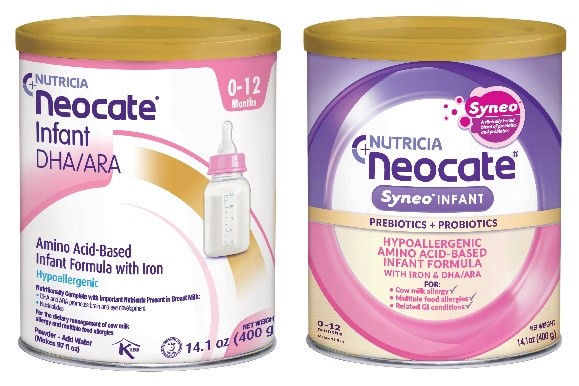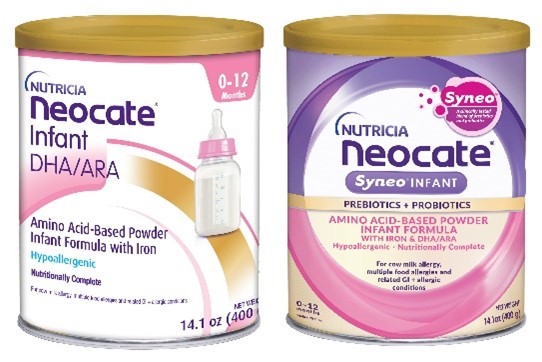What is changing with Neocate Syneo Infant and Neocate Infant?
As you may be aware, the U.S. Food and Drug Administration (FDA) changed their guidance on the energy (calorie) declaration for soluble fibers as a result of updated scientific evidence. Previously, soluble fibers were declared as 4 kcal/g, however the revised guidance states soluble fibers should be declared as 2 kcal/g. Therefore, you will see the declared calories per can have decreased for Neocate Syneo Infant from 1900 kcal/can to 1864 kcal/can. As a result of this decrease, most of the nutrient values per 100 kcals have been updated.
While making the above changes we took the opportunity to make minor revisions to other declared nutrient values on the Neocate Syneo Infant and Neocate Infant labels based on the most current data we have from nutrient analysis trends.
Although there are minor updates to the declared label values, there are NO changes to the formulation. The amounts and sources of ingredients, mixing instructions, and ordering information remain the same.
Lastly, other minor updates were also made to our labels, such as the inclusion of our newest logo, kosher and halal symbols were moved to the side of the can, the language used for preparation directions as well as storage has been simplified, and the list of indications for use has been expanded.
What is not changing with Neocate Syneo Infant and Neocate Infant?
Neocate Infant and Neocate Syneo Infant formulations remain the same. There are no changes to the amounts or sources of ingredients, mixing instructions, or ordering information.
When will we receive the formula with the updated labels?
You will start to see the changes on the label in June 2024. The quickest way to identify if you’ve received the updated labels is by looking at the Nutricia logo (see below for reference):

Old labels (note the Nutricia logo)

New labels (note the updated Nutricia logo)
What changes were made to the indications for use? And why were these changes made?
We updated the indications based on the most recent scientific advances in addition to providing specificity around the use of the Neocate infant formulas.
|
|
Old labels |
Updated labels |
|
Neocate Infant DHA/ARA |
|
|
|
Neocate Syneo Infant |
|
|
What is the difference between eosinophilic esophagitis (EoE) and eosinophilic gastrointestinal disorders (EGIDs)?
Eosinophilic gastrointestinal (GI) disorders (EGIDs) is an umbrella term for diseases involving pathologic eosinophil infiltration into any segment of the GI tract that occurs in the absence of secondary causes of eosinophilia. Eosinophils are a normal part of the immune system which play a role in destroying foreign substances and regulating inflammation. However, high numbers of eosinophils for extended periods of time can lead to chronic inflammation, resulting in tissue damage, as is the case for EGIDs.
EGIDs are classified as either eosinophilic esophagitis (EoE) or non-EoE EGIDs. EoE is the most prevalent of the various types of EGIDs, and is an allergic GI disorder characterized by abnormally high levels of eosinophils (i.e. eosinophilia) in the esophagus, leading to esophageal inflammation and narrowing. Non-EoE EGIDs include eosinophilic gastritis (EoG), eosinophilic enteritis (EoN), and eosinophilic colitis (EoC). EoG indicates stomach eosinophilia, EoN indicates small intestine eosinophilia, and EoC indicates colon eosinophilia.
Dellon, et al. Clin Gastroenterol Hepatol. 2022;20:2474-84.e3.
Have the product codes changed?
No, the product codes have not changed. The product code for Neocate Syneo Infant remains as 127049 and Neocate Infant DHA/ARA as 125626.
Has the reimbursement information changed?
The reimbursement codes, HCPCS code, and product packaging has not changed. However, the total declared calories per can in Neocate Syneo Infant has decreased from 1900 to 1864. The total calories per can of Neocate Infant DHA/ARA remains the same at 1932.
Will there be any change to taste, tolerance, or hypoallergenicity?
No, the formula has not changed and therefore there are no changes to taste, tolerance, or hypoallergenicity.
Exactly what nutrient declarations changed?
The tables below include a comparison of the nutrient declarations for both Neocate Syneo Infant and Neocate Infant DHA/ARA. The values highlighted in red indicate a change in the nutrient declaration was made.
|
|
Old label Per 100 kcal |
New label Per 100 kcal |
|
Calories |
100 |
100 |
|
Protein equivalent, g |
2.8 |
2.9 |
|
Fat, g |
4.8 |
4.9 |
|
Carbohydrate, g |
11.3 |
11.4 |
|
Soluble fiber, g |
0.95 |
0.91 |
|
Linoleic acid, mg |
705 |
718 |
|
Vit. A, IU (mcg RE) |
285 (85.5) |
290 (87.1) |
|
Vit. D, IU (mcg) |
74.1 (1.9) |
75.5 (1.9) |
|
Vit. E, IU (mg α-TE) |
1.4 (0.93) |
1.4 (0.94) |
|
Vit. K, mcg |
9.0 |
9.1 |
|
Thiamine, mcg |
110 |
116 |
|
Riboflavin, mcg |
114 |
116 |
|
Vit. B6, mcg |
114 |
116 |
|
Vit. B12, mcg |
0.27 |
0.28 |
|
Niacin, mcg |
1032 |
1052 |
|
Folic acid, mcg |
13.5 |
13.7 |
|
Pantothenic acid, mcg |
611 |
622 |
|
Biotin, mcg |
4.0 |
4.1 |
|
Vit. C, mg |
10.9 |
11.1 |
|
Choline, mg |
20.1 |
20.5 |
|
Inositol, mg |
22.7 |
23.2 |
|
Calcium, mg |
116 |
118 |
|
Phosphorus, mg |
81.7 |
83.3 |
|
Magnesium, mg |
10.5 |
10.7 |
|
Iron, mg |
1.5 |
1.5 |
|
Zinc, mg |
1.1 |
1.1 |
|
Manganese, mcg |
40.0 |
40.8 |
|
Copper, mcg |
84.2 |
85.8 |
|
Iodine, mcg |
20.6 |
21.0 |
|
Molybdenum, mcg |
2.3 |
2.4 |
|
Chromium, mcg |
2.2 |
2.2 |
|
Selenium, mcg |
3.0 |
3.1 |
|
Sodium, mg |
38.9 |
39.7 |
|
Potassium, mg |
108 |
111 |
|
Chloride, mg |
79.6 |
81.1 |
|
|
Old label Per 100 kcal |
New label Per 100 kcal |
|
Calories |
100 |
100 |
|
Protein equivalent, g |
2.8 |
2.8 |
|
Fat, g |
5.1 |
5.1 |
|
Carbohydrate, g |
10.8 |
10.8 |
|
Linoleic acid, mg |
738 |
738 |
|
Vit. A, IU (mcg RE) |
280 (84.1) |
280 (84.1) |
|
Vit. D, IU (mcg) |
72.9 (1.8) |
72.9 (1.8) |
|
Vit. E, IU (mg α -TE) |
1.4 (0.94) |
1.4 (0.95) |
|
Vit. K, mcg |
8.8 |
8.8 |
|
Thiamine, mcg |
110 |
112 |
|
Riboflavin, mcg |
110 |
112 |
|
Vit. B6, mcg |
112 |
112 |
|
Vit. B12, mcg |
0.27 |
0.27 |
|
Niacin, mcg |
1014 |
1014 |
|
Folic acid, mcg |
13.3 |
13.3 |
|
Pantothenic acid, mcg |
600 |
600 |
|
Biotin, mcg |
3.9 |
3.9 |
|
Vit. C, mg |
10.7 |
10.7 |
|
Choline, mg |
19.8 |
19.8 |
|
Inositol, mg |
22.4 |
22.4 |
|
Calcium, mg |
116 |
116 |
|
Phosphorus, mg |
82.2 |
82.2 |
|
Magnesium, mg |
10.6 |
10.6 |
|
Iron, mg |
1.5 |
1.5 |
|
Zinc, mg |
1.1 |
1.1 |
|
Manganese, mcg |
41.4 |
41.4 |
|
Copper, mcg |
84.9 |
84.9 |
|
Iodine, mcg |
20.7 |
20.7 |
|
Molybdenum, mcg |
2.3 |
2.3 |
|
Chromium, mcg |
2.2 |
2.2 |
|
Selenium, mcg |
3 |
3.0 |
|
Sodium, mg |
39.1 |
39.1 |
|
Potassium, mg |
109 |
109 |
|
Chloride, mg |
79.9 |
79.9 |
Are there any changes to the directions for preparation and use?
No, the overall directions for preparation and use did not change for either formula. We updated the wording around the directions for preparation and use on the Neocate Infant DHA/ARA label. Neocate Infant DHA/ARA and Neocate Syneo should still be prepared at a 1:1 ratio, one unpacked, level scoop of powder to each 1 fl oz of water (unless directed otherwise by the healthcare professional).
One can of Neocate Infant DHA/ARA still provides approximately 97 fl oz and one can of Neocate Syneo Infant still provides approximately 95 fl oz.
Are there any changes to the storage instructions?
No, the storage instructions have not changed.
Unopened or opened cans of Neocate Infant DHA/ARA should continue to be stored in a cool, dry place. Once opened, the can lid should be replaced and used within one month.
Unopened or opened cans of Neocate Syneo Infant should continue to be stored in a cool, dry place. Once opened, the can lid should be replaced and used within two weeks.






